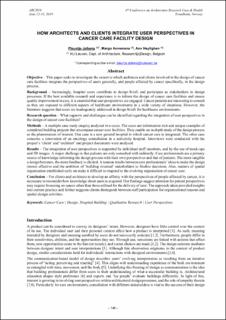| dc.contributor.author | Jellema, Pleuntje | |
| dc.contributor.author | Annemans, Margo | |
| dc.contributor.author | Heylighen, Ann | |
| dc.date.accessioned | 2021-12-28T12:10:54Z | |
| dc.date.available | 2021-12-28T12:10:54Z | |
| dc.date.issued | 2021 | |
| dc.identifier.isbn | 978-82-536-1718-3 | |
| dc.identifier.issn | 2387-4295 | |
| dc.identifier.uri | https://hdl.handle.net/11250/2835517 | |
| dc.description.abstract | Objective – This paper seeks to investigate the extent to which architects and clients involved in the design of cancer care facilities integrate the perspectives of users generally, and people affected by cancer specifically, in the design process.
Background – Increasingly, hospital users contribute to design briefs and participate as stakeholders in design processes. If the best available research and experience is to inform the design of cancer care facilities and ensure quality improvement in care, it is essential that user perspectives are engaged. Cancer patients are interesting to consult as they are exposed to different aspects of healthcare environments in a wide variety of situations. However, the literature suggests that users are inadequately addressed in design briefs for healthcare environments.
Research question – What supports and challenges can be identified regarding the integration of user perspectives in the design of cancer care facilities?
Methods – A multiple case study enquiry analysed two cases. The cases are information-rich and unique examples of completed building projects that encompass cancer care facilities. They enable an in-depth study of the design process as the phenomenon of interest. One case is a new general hospital in which cancer care is integrated. The other case concerns a renovation of an oncology consultation in a university hospital. Interviews were conducted with the project’s ‘client’ and ‘architect’ and project documents were analysed.
Results – The integration of user perspectives is supported by individual staff members, and by the use of mock-ups and 3D images. A major challenge is that patients are only consulted with indirectly. Care professionals are a primary source of knowledge informing the design process with their own perspectives and that of patients. The more tangible a design becomes, the more feedback is elicited. A tension results between care professionals’ ideas to make the design (more) effective and the ambition of ‘building oriented’ stakeholders to finalise decisions. Also, matters of spatial organisation established early on make it difficult to respond to the evolving organisation of cancer care.
Conclusion – For clients and architects to develop an affinity with the perspectives of people affected by cancer, it is necessary to reconsider how knowledge about users is acquired. Our findings suggest attention for patient perspectives may require focussing on spaces other than those utilised for the delivery of care. The approach taken provided insights into current practice and further suggests clients distinguish between staff participation for organisational reasons and spatial design activities. | |
| dc.language.iso | eng | |
| dc.publisher | SINTEF Academic Press | |
| dc.relation.ispartof | ARCH19 June 12–13, 2019 – Trondheim, Norway. Proceedings from the 4th Conference on Architecture Research Care & Health | |
| dc.relation.ispartofseries | SINTEF Proceedings;8 | |
| dc.rights | CC BY 4.0 | |
| dc.rights.uri | https://creativecommons.org/licenses/by/4.0/ | |
| dc.subject | Cancer Care | |
| dc.subject | Design | |
| dc.subject | Hospital Building | |
| dc.subject | Qualitative Research | |
| dc.subject | User Perspectives | |
| dc.title | How Architects and Clients Integrate User Perspectives in Cancer Care Facility Design | |
| dc.type | Chapter | |
| dc.type | Peer reviewed | |
| dc.type | Conference object | |
| dc.description.version | publishedVersion | |
| dc.rights.holder | © 2021 The Authors. | |
| dc.subject.nsi | VDP::Medisinske Fag: 700::Helsefag: 800 | |

